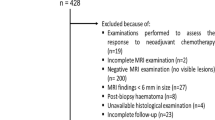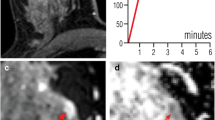Abstract
Objective
To develop and assess a combined reading for contrast-enhanced magnetic resonance (CE-MRI) and diffusion weighted imaging (DWI) adapted to the BI-RADS for multiparametric MRI of the breast at 3 T.
Methods
A total of 247 patients with histopathologically verified breast lesions were included in this IRB-approved prospective study. All patients underwent CE-MR and DWI at 3 T. MRIs were classified according to BI-RADS and assessed for apparent diffusion coefficient (ADC) values. A reading method that adapted ADC thresholds to the assigned BI-RADS classification was developed. Sensitivity, specificity, diagnostic accuracy and the area under the curve were calculated. BI-RADS-adapted reading was compared with previously published reading methods in the same population. Inter- and intra-reader variability was assessed.
Results
Sensitivity of BI-RADS-adapted reading was not different from the high sensitivity of CE-MRI (P = 0.4). BI-RADS-adapted reading maximised specificity (89.4 %), which was significantly higher compared with CE-MRI (P < 0.001). Previous reading methods did not perform as well as the BI-RADS method except for a logistic regression model. BI-RADS-adapted reading was more sensitive in non-mass-like enhancements (NMLE) and was more robust to inter- and intra-reader variability.
Conclusion
Multiparametric 3-T MRI of the breast using a BI-RADS-adapted reading is fast, simple to use and significantly improves the diagnostic accuracy of breast MRI.
Keypoints
• Multiparametric breast 3-T MRI with BI-RADS-adapted reading improves diagnostic accuracy.
• BI-RADS-adapted reading of CE-MRI and DWI is based on established reporting guidelines.
• BI-RADS-adapted reading is fast and easy to use in routine clinical practice.
• BI-RADS-adapted reading is robust to intra- and inter-reader variability.






Similar content being viewed by others
References
Jacobs MA, Barker PB, Bluemke DA et al (2003) Benign and malignant breast lesions: diagnosis with multiparametric MR imaging. Radiology 229:225–232
Pinker K, Bogner W, Gruber S et al (2011) Molecular imaging in breast cancer - potential future aspects. Breast Care (Basel) 6:110–119
Jacobs MA (2009) Multiparametric magnetic resonance imaging of breast cancer. J Am Coll Radiol 6:523–526
Moradi M, Salcudean SE, Chang SD, et al. (2012) Multiparametric MRI maps for detection and grading of dominant prostate tumors. J Magn Reson Imaging 35:1403–1413
Ei Khouli RH, Jacobs MA, Mezban SD et al (2010) Diffusion-weighted imaging improves the diagnostic accuracy of conventional 3.0-T breast MR imaging. Radiology 256:64–73
Partridge SC, DeMartini WB, Kurland BF, Eby PR, White SW, Lehman CD (2009) Quantitative diffusion-weighted imaging as an adjunct to conventional breast MRI for improved positive predictive value. AJR Am J Roentgenol 193:1716–1722
Yabuuchi H, Matsuo Y, Kamitani T et al (2010) Non-mass-like enhancement on contrast-enhanced breast MR imaging: lesion characterization using combination of dynamic contrast-enhanced and diffusion-weighted MR images. Eur J Radiol 75:e126–132
Yabuuchi H, Matsuo Y, Okafuji T et al (2008) Enhanced mass on contrast-enhanced breast MR imaging: lesion characterization using combination of dynamic contrast-enhanced and diffusion-weighted MR images. J Magn Reson Imaging: JMRI 28:1157–1165
Kul S, Cansu A, Alhan E, Dinc H, Gunes G, Reis A (2011) Contribution of diffusion-weighted imaging to dynamic contrast-enhanced MRI in the characterization of breast tumors. AJR Am J Roentgenol 196:210–217
Sardanelli F, Boetes C, Borisch B et al (2010) Magnetic resonance imaging of the breast: recommendations from the EUSOMA working group. Eur J Cancer 46:1296–1316
American College of Radiology (ACR) Breast Imaging Reporting and Data System Atlas (BI-RADS® Atlas). American College of Radiology, Reston, VA. http://www.acr.org/Quality-Safety/Resources/BIRADS/Mammography
Bogner W, Gruber S, Pinker K et al (2009) Diffusion-weighted MR for differentiation of breast lesions at 3.0 T: how does selection of diffusion protocols affect diagnosis? Radiology 253:341–351
Pinker K, Grabner G, Bogner W et al (2009) A combined high temporal and high spatial resolution 3 Tesla MR imaging protocol for the assessment of breast lesions: initial results. Investig Radiol 44:553–558
Pinker-Domenig K, Bogner W, Gruber S et al (2012) High resolution MRI of the breast at 3 T: which BI-RADS(R) descriptors are most strongly associated with the diagnosis of breast cancer? Eur Radiol 22:322–330
Rosset A, Spadola L, Ratib O (2004) OsiriX: an open-source software for navigating in multidimensional dicom images. J Digit Imaging 17:205–216
Bogner W, Pinker K, Bickel H et al (2012) Readout-segmented echo-pianar imaging improves the diagnostic performance of diffusion-weighted MR imaging breast examinations at 3.0 T. Radiology 263:64–76
Woodhams R, Matsunaga K, Kan S et al (2005) ADC mapping of benign and malignant breast tumors. J Magn Reson Med Sci 4:35–42
Wallis M, Tardivon A, Helbich T, Schreer I (2007) Guidelines from the European Society of Breast Imaging for Diagnostic Interventional Breast Procedures. Eur Radiol 17:581–588
Pathologists RCo (2001) NHS Cancer Screening Programmes: Guidelinesfor non-operative diagnostic procedures and reporting in breast cancer screening. NSHBSP publication, Sheffield. http://www.cancerscreening.nhs.uk/breastscreen/publications/nhsbsp02.pdf
Pathology EWGoBS (2006) Quality assurance guidelines for pathologyEuropean guidelines for quality assurance in cancer screening and diagnosis, 4th edn. European Union, pp 219–312
Kluttig A, Trocchi P, Heinig A et al (2007) Reliability and validity of needle biopsy evaluation of breast-abnormalities using the B-categorization–design and objectives of the Diagnosis Optimisation Study (DIOS). BMC Cancer 7:100
Hanley JA, McNeil BJ (1983) A method of comparing the areas under receiver operating characteristic curves derived from the same cases. Radiology 148:839–843
Bland JM, Altman DG (1986) Statistical methods for assessing agreement between two methods of clinical measurement. Lancet 1:307–310
Pinker K, Stadlbauer A, Bogner W, Gruber S, Helbich TH (2010) Molecular imaging of cancer: MR spectroscopy and beyond. Eur J Radiol 81:566–77
Steyerberg E (2009) Overfitting and optimism in prediction models. Clinical Prediction Models. Statistics for Biology and Health 83–100
Sakamoto N, Tozaki M, Higa K et al (2008) Categorization of non-mass-like breast lesions detected by MRI. Breast Cancer 15:241–246
Tozaki M, Fukuda K (2006) High-spatial-resolution MRI of non-masslike breast lesions: interpretation model based on BI-RADS MRI descriptors. AJR Am J Roentgenol 187:330–337
Woodhams R, Kakita S, Hata H et al (2009) Diffusion-weighted imaging of mucinous carcinoma of the breast: evaluation of apparent diffusion coefficient and signal intensity in correlation with histologic findings. AJR Am J Roentgenol 193:260–266
Iima M, Le Bihan D, Okumura R et al (2011) Apparent diffusion coefficient as an MR imaging biomarker of low-risk ductal carcinoma in situ: a pilot study. Radiology 260:364–372
Rahbar H, Partridge SC, Eby PR et al (2011) Characterization of ductal carcinoma in situ on diffusion weighted breast MRI. Eur Radiol 21:2011–2019
Bianchi S, Caini S, Cattani MG, Vezzosi V, Biancalani M, Palli D (2009) Diagnostic concordance in reporting breast needle core biopsies using the B classification-A panel in Italy. Pathol Oncol Res 15:725–732
Bianchi S, Caini S, Renne G et al (2011) Positive predictive value for malignancy on surgical excision of breast lesions of uncertain malignant potential (B3) diagnosed by stereotactic vacuum-assisted needle core biopsy (VANCB): a large multi-institutional study in Italy. Breast 20:264–270
Simpson PT, Reis-Filho JS, Gale T, Lakhani SR (2005) Molecular evolution of breast cancer. J Pathol 205:248–254
Ellsworth RE, Ellsworth DL, Deyarmin B et al (2005) Timing of critical genetic changes in human breast disease. Ann Surg Oncol 12:1054–1060
Riedl CC, Ponhold L, Flory D et al (2007) Magnetic resonance imaging of the breast improves detection of invasive cancer, preinvasive cancer, and premalignant lesions during surveillance of women at high risk for breast cancer. Clin Cancer Res 13:6144–6152
Unal O, Koparan HI, Avcu S, Kalender AM, Kisli E (2011) The diagnostic value of diffusion-weighted magnetic resonance imaging in soft tissue abscesses. Eur J Radiol 77:490–494
Oto A, Schmid-Tannwald C, Agrawal G et al (2011) Diffusion-weighted MR imaging of abdominopelvic abscesses. Emerg Radiol 18:515–524
Kuijper A, Mommers EC, van der Wall E, van Diest PJ (2001) Histopathology of fibroadenoma of the breast. Am J Clin Pathol 115:736–742
Kopans DB (1994) Caution on core. Radiology 193:325–326, discussion 326–328
Acknowledgments
The Austrian National Bank ‘Jubiläumsfond’ project no. 13652, 13834, 13629 and 13418 and the Medical Scientific Fund of the Mayor of Vienna project no. 10029.
Author information
Authors and Affiliations
Corresponding author
Rights and permissions
About this article
Cite this article
Pinker, K., Bickel, H., Helbich, T.H. et al. Combined contrast-enhanced magnetic resonance and diffusion-weighted imaging reading adapted to the “Breast Imaging Reporting and Data System” for multiparametric 3-T imaging of breast lesions. Eur Radiol 23, 1791–1802 (2013). https://doi.org/10.1007/s00330-013-2771-8
Received:
Revised:
Accepted:
Published:
Issue Date:
DOI: https://doi.org/10.1007/s00330-013-2771-8




